
Australian operated

Australian operated
Free on-site visit & quote
Over 14,000+ homes protected
5/5 stars is most frequent rating
Do you think you have found or seen Termites in your home? We can help you be sure with correct identification with this in depth article. Of course if you’re still unsure call us and we will visit onsite for identification.
Also, be sure to check out our Termite Identification pages
Termites are also commonly called white ants because they are often mistaken with ants. Termites are quite large compared to normal black ants commonly seen by homeowners around the home. Termites are slightly larger than ants and usually 0.7 mm – 1 cm in length. If you have found termites there is a good chance they have retreated the disturbed area. But don’t worry, they will be back! So, don’t spray them with fly spray or any DIY termite treatment products.
Termite size can vary depending on their role within the colony. While worker termites are typically 0.7 mm to 1 cm in length, soldier termites are usually larger with broad heads and large mandibles. Queen termites, on the other hand, can grow up to 2-3 inches long and are the largest in the colony.
Are termites bigger than ants? Yes, termites are generally larger than ants, although some species of ants can be quite large. For example, black termites (often confused with ants) are considerably bigger than black garden ants.
Termites are typically white, cream, or pale yellow, especially the worker termites. However, they can also be darker in colour depending on the species. For instance, black termites are often confused with ants due to their dark colour and size.
A termite colony consists of
Let’s show you exactly what each termite type looks like.
Workers work 24/7 gathering food for the family , They constantly consume wood and feed in throughout and back to the colony/nest. They feed the young and construct mud tunnels and gallery’s usually in the top 30 cm of soil in constant search for food. These termites feed on hard and soft wood throughout the ground or in some cases your home. If they find a way into your home its basically a big tree to them.
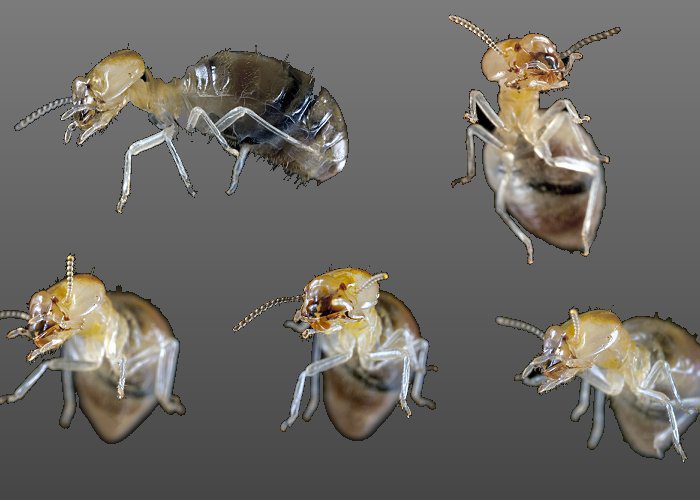
Worker termites are usually creamy white in colour and have a soft body,They do however have hard mouth-parts allowing them to eat through wood. Believe it or not these worker termites are blind and can be male or female.
Termite Soldiers are easily spotted by their large jaws used to defend the colony if disturbed, Chances are if you have found and disturbed termites , within a few minutes you will only see the soldier termites. When Termites are disturbed the workers will immediately retreat the area and usually go back underground quickly. Over time the termite workers will come back to the area when safe.
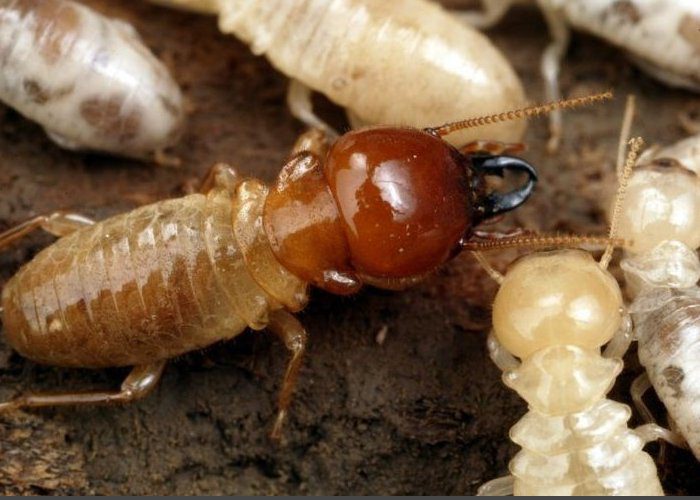
These Termites defend the colony and have a large head usually gold/brown in color and black mandibles (Jaws) These jaws are used in defense to slash,cut, or crush common enemy’s like ants. These termites are also blind,wingless and have a soft body. As they have jaws for defense it is difficult for them to feed on wood like the workers, Worker termites will feed the soldiers liquid food (Previously consumed wood by the worker termites)
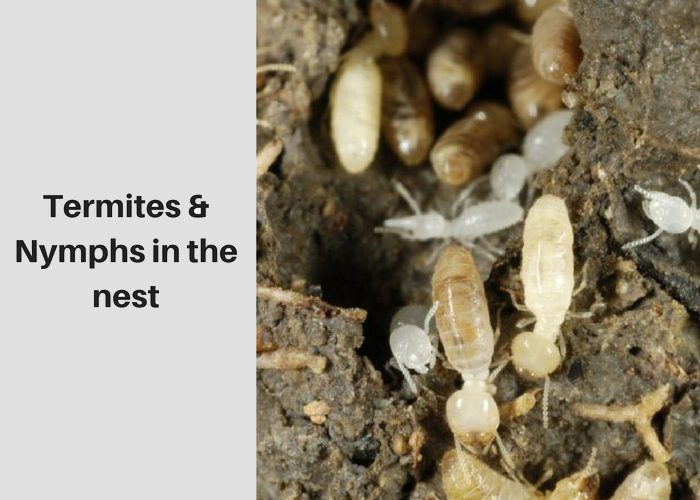
Towards the end of summer large mature termite colony’s produce a huge amount of reproductives, These are larger than normal termites and stand out due to having elongated wing buds forming on their backs. These termites eventually molt and turn into winged sexually mature male and female termites commonly called elates or swarmers.
At certain times of the year thousands and thousands of swarming termites will fly out from their colony’s to start new ones. Yes that’s right, Termites are always on the move, After they fly out from their colony’s they can fly up to kilometers away and find a mate and reproduce into another thriving termite colony.
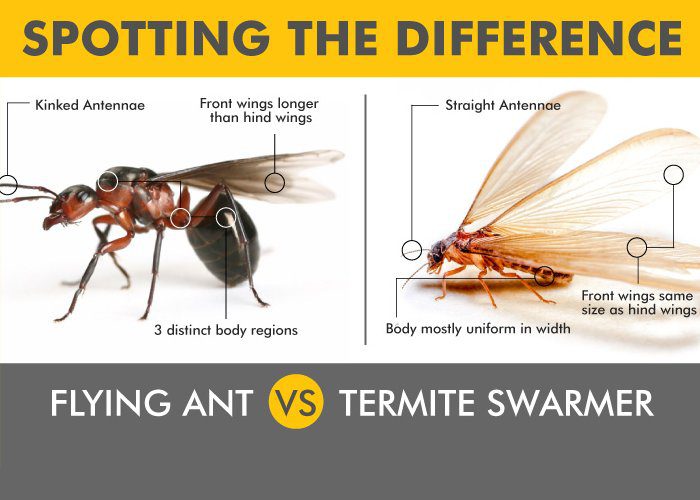
As described above these termite swarms can sometimes be in the millions and sometimes even form great clouds that darken the sky as the suns going down. These swarmers are attracted to light and commonly enter your ceiling through guttering and drop down through your down-lights. Although thousands or millions of swarmers fly out from the colony only a small amount survive (Usually 10%). Swarmers have a list of enemy’s to get through before finding a mate and settling down to form another colony. Birds, bats will feed on flying termites, Once they land they also encounter lizards , frogs, toads , ants or spider webs.
Termite queens in established colony’s can be up to 2-3 inches long and are normally never seen as they stay in the nest usually in the base of a tree or under ground. The termite queen is basically a termite egg laying machine! Usually laying over 2000 eggs per day. She is spoilt fed by the workers and can live over a decade producing termites by the millions.
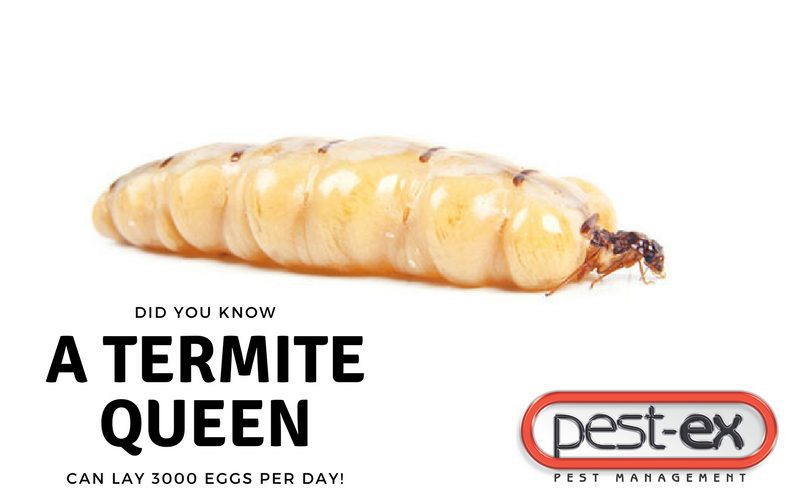
The termite king also assists with caring and feeding of the young and services the queen as needed.
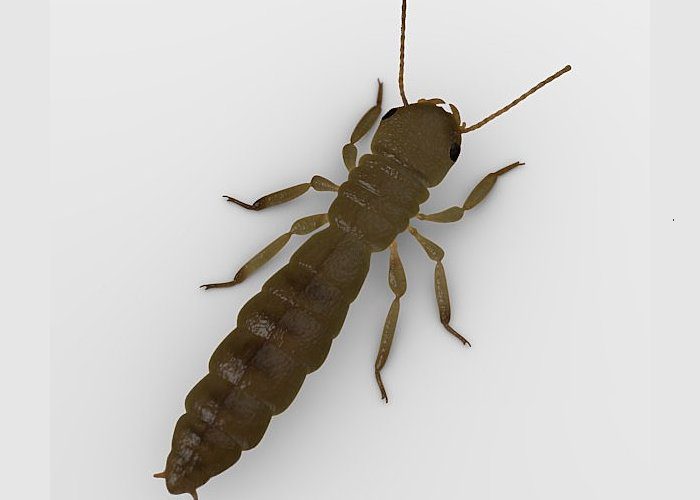
Many people confuse termites with ants, especially because of their similar appearance. Termites in Australia are typically larger than ants. While regular ants range from 1-2 mm, worker termites are generally 0.7 mm to 1 cm in length, making them slightly larger than most ants. Soldier termites are even bigger, with heads that are broader and more pronounced.
Interestingly, black termites can often be mistaken for ants, especially when swarming, but their bodies are usually thicker, and they have straight antennae, unlike the elbowed antennae of ants.
Yes, termites do fly, but only during specific times of the year, usually in the warmer months after rain. This is when swarming termites (also called alates or winged termites) leave their colony to mate and establish new colonies. Termite swarms are often attracted to light, which is why they might be seen flying around windows, outdoor lights, or ceiling lights in your home.
While their swarming season can create large numbers, only a small portion of the flying termites survive to form new colonies. The appearance of flying termites is a sign that a nearby colony may be active. If you spot them, it’s crucial to act quickly to prevent an infestation and avoid further damage to your property.
Check out this video at Danny’s (Pest-Ex Business owners) home recently, After rain and a warm day the termites arrived in their millions. This proves no home is safe from termites.
Yes, they do! Termites are known to create a clicking or banging sound when disturbed. The soldier termites bang their heads or shake their bodies against the walls to warn the colony of danger. This behaviour is often heard in the evening when termites are most active.
“When disturbed, termites produce a distinct clicking or banging sound, typically caused by soldier termites banging their heads or vibrating their bodies to alert the colony to danger. This sound may also be heard when termites are feeding or moving through wood, and it can sometimes be noticeable in quiet spaces, like attics or crawl spaces.”
If you’re wondering what termites sound like, it’s similar to the noise made when you snap your fingers or when rice bubbles pop in a bowl of milk.
This video was filmed and discovered during a termite inspection.
Identifying termites can be tricky, but with the right knowledge, you can spot the signs before they cause major damage. Termite identification in Australia is particularly important because the species here differ from those in other parts of the world, and different termites may require different treatment methods.
What do termites look like? In Australia, termites can vary in color and size, but most species are creamy white or pale yellow. Worker termites are usually white or pale cream, while soldier termites tend to have darker heads with large jaws. Some species, such as black termites, are darker in color, and swarming termites can sometimes appear darker with wings during mating seasons.
When inspecting your home, look for:
Choose Pest Ex for your pest control and termite treatment needs because:
If you have any termite concerns please get in touch.







